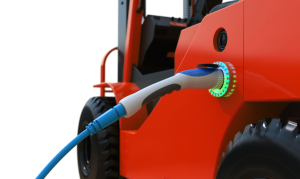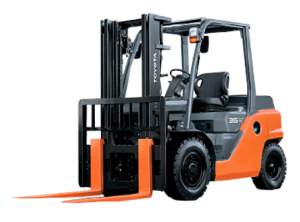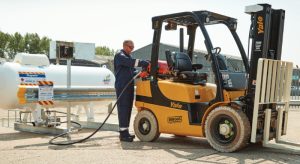Choosing the correct fuel for your forklift truck is an important decision. Not only does it affect the performance of your machine, but it also has a big impact on costs. In this article, we’ll discuss everything you need to know about forklift fuel so that you can make an informed decision when selecting a fuel type for your forklifts and your business.
In this article, we will cover:
- The Different forklift fuel types
- Pros and Cons For Each
- Cost Considerations
- Sustainability, Pollution And Safety
- And More!
Let’s dive in!
What Type Of Fuel Do Forklifts Typically Run On?
The most popular types of fuel for forklift trucks are gasoline, diesel, propane and electric. Each type has its advantages and disadvantages, which will be discussed in more detail below. It’s important to note that different manufacturers may have their specifications for what type of fuel is suitable for use with their machines.
LPG was by far the most popular until recent years, but electricity has now taken over and is the most widely used. Electric-powered lifts are quieter, less polluting and often require less maintenance.
Find Your Perfect Forklift
Compare Quotes from Local Forklift Dealerships


Enter Requirements


We Find the Best Deal


Receive your Quote
Electric Forklifts
 Electric Forklifts are more popular than ever! Powered by a forklift battery, so there is no need to refuel. They don’t produce emissions, so have a positive environmental impact and are usually more compact than other options. It’s easy to see why electric forklifts are a popular choice for many businesses.
Electric Forklifts are more popular than ever! Powered by a forklift battery, so there is no need to refuel. They don’t produce emissions, so have a positive environmental impact and are usually more compact than other options. It’s easy to see why electric forklifts are a popular choice for many businesses.
Advantages
- Environmentally Friendly – Electric forklifts do not produce any emissions, so they are much kinder to the environment and safer for employees in indoor applications.
- Running Cost Effective – Electric forklifts can be cheaper to run as electricity costs are usually lower than fuel costs.
- Quiet – Electric forklifts are much quieter than their diesel-powered counterparts, creating a more pleasant work environment.
- More Compact – Electric forklifts are usually more lightweight and compact than other fuel types due to there being no fuel tank required meaning they can fit into tighter spaces, allowing you to maximise efficiency.
Disadvantages
- High Initial Cost – When compared to gasoline and diesel-powered models, electric forklifts are usually more expensive to purchase outright.
- Limited Operating Time – Electric forklifts tend to have a limited operating time as they require recharging. This can be seen as an advantage in some instances such as temperature-controlled storage facilities, but could prove to be inconvenient in others.
- Requires Dedicated Charging Space – Electric forklifts require a dedicated charging area or space to charge the batteries. This may be a big issue if your operating in a warehouse with limited space.
Most Common Uses
Electric forklifts are commonly used for indoor applications in areas like warehouses, storage facilities and loading docks. They are also great for the retail and hospitality industries as they can be used to handle items quietly and efficiently.
Price And Associated Costs
By far the biggest cost associated with electric forklifts is the initial purchase price. Electric forklifts tend to be more expensive than their gasoline and diesel counterparts, but this cost can give a good return on investment due to lower running costs.
Because electric forklifts don’t have as many moving parts as gasoline and diesel models, they require less maintenance. There are no oil changes, spark plug replacements or fuel filter maintenance involved. This means a lower cost of ownership and reduced downtime.
Another big cost when it comes to electric forklifts is batteries, there are a few different types of forklift batteries available today each with its benefits and drawbacks, read our guide on forklift batteries here.
Other costs you need to consider are:
- The setup and maintenance of a dedicated charging station and area.
- Replacement batteries and charging infrastructure.
- Regular inspections and maintenance.
Diesel Forklifts
 Diesel forklifts are the most powerful type of lift truck and are suitable for a wide range of applications, from warehouses to construction sites. They have been around for many years and are popular due to their lifting capacity, durability, power, and low running costs.
Diesel forklifts are the most powerful type of lift truck and are suitable for a wide range of applications, from warehouses to construction sites. They have been around for many years and are popular due to their lifting capacity, durability, power, and low running costs.
Advantages
- Powerful – Forklifts with diesel engines are the most powerful type of lift trucks, making them ideal for heavy-duty applications such as transport, construction and mining.
- Low Running Costs – Due to their high efficiency, diesel-powered lifts require less fuel than other types, resulting in lower running costs.
- Longer Operating Time – Diesel-powered forklifts can usually operate for longer due to their larger fuel tanks, resulting in fewer trips for refuelling.
- Suitable For Outdoor Use – Diesel-powered forklifts are more suitable for outdoor use and can operate in challenging conditions.
Disadvantages
- Noise And Emissions – Diesel-powered forklifts can be noisy and emit fumes, making them less suitable for some applications.
- Maintenance Requirements – Due to their high power output, diesel-powered lifts require regular maintenance and servicing.
- Less usable Indoors – Due to their emissions, diesel-powered lifts are not suitable for most indoor applications.
Most Common Uses
Diesel-powered forklifts are ideal for outdoor applications such as construction sites, transport and logistics, mining, and agriculture. They are also suitable for indoor use in larger warehouses or manufacturing facilities where their robustness and power can be utilised and proper safety precautions are being taken.
Price And Associated Costs
The purchase price of diesel-powered forklifts can be higher than that of electric and gasoline models, this is because of the power output and extra features they offer.
Regular maintenance is required to keep the diesel fuel forklift running at its best, however, due to their durability, these vehicles will last for many years with proper care and attention.
Other costs associated with a diesel-powered lift are:
- Fuel and oil changes.
- Spark plugs and filters.
- Regular inspections.
Liquid Petroleum Gas (LPG) Forklifts

Image Source: Avantigas.com
Liquid Petroleum Gas (LPG) forklifts sometimes just called “gas forklifts” are a popular option in many industries, especially the warehousing and hospitality industry. They are well-suited to most indoor and outdoor use due to their low emissions and quiet operation.
Advantages
- Low Harmful Emissions – LPG-powered forklifts emit fewer pollutants than other types, making them suitable for indoor use in some areas.
- Quiet Operation – LPG-powered lifts are usually quieter than diesel and gasoline models, making them more suitable for noise-sensitive applications.
- Longer Operating Time – An LPG-powered forklift can usually operate for longer due to its larger fuel tank, resulting in less time spent refuelling.
Disadvantages
- Less Power – LPG-powered forklifts do not have the same power output as diesel or electric models and are better suited to lighter applications.
- Costs – Due to the required infrastructure for storage and refuelling of LPG, these lifts can be more expensive to operate than electric or diesel models.
- Maintenance Requirements – LPG-powered forklifts require regular maintenance and servicing to keep them running optimally.
Most Common Uses
LPG-powered forklifts are ideal for indoor applications such as warehouses and hospitality, where their low emissions and quiet operation make them suitable. They can also be used outdoors in some cases, with proper safety precautions taken.
Price And Associated Costs
The purchase price of an LPG-powered forklift can be slightly lower than other types, but it is usually more expensive to operate due to the cost of fuel.
Regular maintenance and servicing are required to keep the lift running at its best, however, due to their reliability, these vehicles will last for many years with proper care and attention.
Other costs associated with an LPG-powered forklift are:
- Gas cylinders and storage equipment.
- Oil changes.
- Spark plugs and filters.
- Regular inspections.
Other Forklift Fuel Options
Although we have covered the 3 most commonly used forklift types, other fuel options are available but are rare in the modern forklift industry. These include:
Compressed Natural Gas (CNG) Forklifts
CNG-powered forklifts have similar advantages to gas powered forklifts, however, they are slightly more expensive due to the higher cost of fuel and are not as commonly found in most industrial settings.
A major advantage of using a CNG tank system is that it can be easily refilled rather than removed, thereby reducing operator downtime. However, the high cost of setting up a CNG refuelling station due to land requirements, equipment costs, and installation charges poses a significant barrier to entry for smaller operations.
Hybrid Forklifts
Hybrid forklifts sometimes called “dual-fuel forklifts” are powered by a combination of electric power and internal combustion engines, offering the benefits of both with fewer emissions. They can be expensive to purchase but offer low running costs in return.
At present hybrid forklifts are not so common in warehouses due to their relatively high purchase price and maintenance costs however, in the future, they could become more commonplace as technology advances.
Gasoline Only Forklifts
Gasoline powered forklifts have become very rare in recent years due to the high costs associated with setting up refuelling stations, as well as the noise that is produced when operating these vehicles. They are only suitable for outdoor applications in some cases and are not as efficient or cost-effective as other types of lift trucks.
How To Choose The Right Fuel Type For Your Business
When deciding on the ideal forklift for your business, it is important to consider several factors such as cost, power output, running costs, and maintenance requirements.
It is also important to think about the environment where the forklift will be used and what type of application it will mainly be used for. Consider whether you need an indoor or outdoor forklift and the associated safety requirements.
For most businesses, electric and diesel-powered lifts are the best option due to their reliable power output, cost efficiency, and low emissions. However, if you need a quieter operation or your application requires lighter loads, then LPG may be worth considering.
Ultimately, choosing the right forklift fuel type for your business depends on several factors and should be discussed with a knowledgeable representative to ensure you make the best decision.
If you are unsure which fuel option is best for your business get in touch with Forkify today and one of our trusted partners with decades of experience will be more than happy to assist you!
With careful consideration and research, you can make an informed decision that will help keep your forklift running safely and efficiently in the long term.
Conclusion
When it comes to selecting the right forklift fuel type for your business, there are many factors to consider to make an informed decision. Depending on your application, costs and environmental awareness, different fuels may be better suited.
We have tried to give you as much information as possible on this topic, but if you are still unsure or have any other questions, our experienced team at Forkify is here to help.
Electric-powered lifts offer the most cost-efficient option and have low emissions, but if you require a quieter operation, or lighter loads, then LPG may be the right choice.